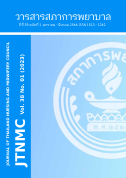ผลของโปรแกรมการจัดการทางการผดุงครรภ์ในระยะคลอดต่อระยะเวลาที่ 2 ของการคลอด ระดับการฉีกขาดของฝีเย็บ และความสุขสบายในผู้คลอดครรภ์แรก
DOI:
https://doi.org/10.60099/jtnmc.v38i01.259715คำสำคัญ:
ท่าคลอดที่มีความยืดหยุ่นของกระดูกก้นกบ, ระยะเวลาที่ 2 ของการคลอด, ระดับการฉีกขาดของฝีเย็บ, ความสุขสบายในระยะคลอดบทคัดย่อ
บทนำ: ระยะที่ 2 ของการคลอดเป็นช่วงเวลาที่สำคัญต่อความปลอดภัยของมารดาและ ทารก ดังนั้นคุณภาพการดูแลในระยะที่ 2 ของการคลอดจึงเป็นสิ่งที่สำคัญที่พยาบาล/ผดุงครรภ์ ต้องให้ความสนใจ
วัตถุประสงค์ของการวิจัย: เพื่อศึกษาผลของโปรแกรมการจัดการทางการผดุงครรภ์ใน ระยะคลอดต่อระยะเวลาที่ 2 ของการคลอด ระดับการฉีกขาดของฝีเย็บ และความสุขสบายในระยะ คลอดของผู้คลอดครรภ์แรก
การออกแบบการวิจัย: การวิจัยเชิงทดลอง แบบสองกลุ่มวัดหลังการทดลอง
วิธีดำเนินการวิจัย: กลุ่มตัวอย่างเป็นผู้คลอดครรภ์แรกที่เข้ารับบริการคลอดในโรงพยาบาล ระดับตติยภูมิแห่งหนึ่งในจังหวัดนครปฐม ระหว่างเดือนเมษายนถึงกันยายน พ.ศ. 2564 จำนวน 50 ราย สุ่มเข้ากลุ่มทดลองหรือกลุ่มควบคุม กลุ่มละ 25 ราย กลุ่มทดลองได้รับโปรแกรมการจัดการทางการ ทางการผดุงครรภ์ในระยะคลอดร่วมกับการพยาบาลตามปกติ ประกอบด้วยระยะที่ 1 ของการคลอด ให้ความรู้ และระยะที่ 2 ของการคลอด จัดท่าคลอดที่มีความยืดหยุ่นของกระดูกก้นกบ เบ่งคลอด แบบธรรมชาติ อยู่เป็นเพื่อนผู้คลอดตลอดเวลา และทำคลอดศีรษะถึงลำตัว 2 ขั้นตอน ส่วนกลุ่มควบคุม ได้รับการพยาบาลตามปกติเพียงอย่างเดียว เก็บรวบรวมข้อมูลโดยใช้แบบบันทึกข้อมูลส่วนบุคคล และข้อมูลทางสูติศาสตร์ และแบบประเมินความสุขสบายในระยะคลอด ซึ่งมีค่าความตรงเชิงเนื้อหา เท่ากับ 1 และค่าความเชื่อมั่นเท่ากับ .81 วิเคราะห์ข้อมูลด้วยสถิติเชิงพรรณนา การทดสอบทีอิสระ และ การทดสอบไคสแควร์
ผลการวิจัย: พบว่า ผู้คลอดกลุ่มทดลองมีระยะเวลาที่ 2 ของการคลอดสั้นกว่า ระดับการฉีกขาด ของฝีเย็บน้อยกว่า และความสุขสบายในระยะคลอดมากกว่ากลุ่มควบคุมอย่างมีนัยสำคัญทางสถิติ (t= - 4.444, p < .001; Corrected Chi-square = 17.469, p < .001; t = 3.402, p< .001 ตามลำดับ)
ข้อเสนอแนะ: พยาบาลผดุงครรภ์ควรนำโปรแกรมการจัดการทางการผดุงครรภ์ในระยะคลอดนี้ ไปประยุกต์ใช้ในการดูแลผู้คลอด
Downloads
เอกสารอ้างอิง
Cunningham FG, Gant NF, Leveno KJ, Gilstrap LC, Hauth JC, Wenstrom KD. Williams obstetrics. 25th ed. Singapore: McGraw-Hill; 2018.
Duangmani K, Somsap Y, Ingkathawomwong T, Kala S. Effects of modified bhadrasana pose on labor pain and duration of active phase in parturients. Puu Sci J 2017;9(2):35-49. (in Thai)
Terry RR, Westcott J, O’Shea L, Kelly F. Postpartum outcomes in supine delivery by physicians vs nonsupine delivery by midwives. JAOA 2006;106(4):199-202.
Lai ML, Lin KC, Li, HY, Shey KS, Gau ML. Effects of delayed pushing during the second stage of labor on postpartum fatigue and birth outcomes in nulliparous women. JONR 2009;17(1):62-72.
Sandstrom A, Altman M, Cnattingius S, Johansson S, Ahlberg M, Stephansson O. Durations of second stage of labor and pushing and adverse neonatal outcomes: a population-based cohort study. J Perinatol 2017;37(3):236-42.
Simkin P, Ancheta R. The labour progress handbook. Blackwell: Science Oxford; 2015.
Ricci, S.S. (2017). Essentials of Maternity, Newborn, & Women’s Health Nursing (4th ed.). Philadelphia: Wolters Kluwer; 2017.
Berta M, Lindgren H, Christensson K, Mekonnen S, Adefris M. Effect of maternal birth positions on duration of second stage of labor: systematic review and meta-analysis. BMC 2019;19:466-76.
Bharti R. (2018). Upright kneeling position during second stage of labor. IJRCOG 2018;7(2):401-07.
Chaitikul S, Yusamran C, Serisathien Y, Ratinthorn A, Seeboonruang S. Effect of spontaneous pushing from squatting position on an innovation birthing seat on duration of the second stage of labor in primiparous parturients. J Nurs Sci 2012;30(3):7-14. (in Thai)
Albers LL, Sedler KD, Bedrick EJ, Teaf D, Peralta P. Factors related to genital tract trauma in normal spontaneous vaginal births. Birth 2006;33(2): 94-100.
Edqvist M, Hildingsson I, Mollberg M, Lundgren I, Lindgren H. Midwives’ management during the second stage of labor in relation to second degree tears. Birth 2016;44(1):86–94.
Yuenyong S, O’Brien B, Jirapaet, V. Effects of labor support from close female relative on labor and maternal satisfaction in a Thai setting. JOGN Nursing 2012;41(1):45-56.
Lowdermilk, DL, Cashion, K, Perry, SE, Alden, KR, Olshansky, E. Maternity & women’s health care. 12th ed. St. Louis: Mosby Elsevier; 2020.
Baker K. Midwives should support women to mobilize during labour. BJM 2010;18(3):492-7.
Gizzo S, Noventa M, Bacile V, Zambon A, Nardelli B. Women’s choice of positions during labour: Return to the past or a modern way to give birth: A cohort study in Italy. BRI 2014;10(4):e1-7.
Tato R. Nursing research: concepts to application. 3rd ed. Bangkok: Chulalongkorn University; 2018. (in Thai)
Institute of Medicime. Weight gain during pregnancy: Reexamining the Guidelines; 2009.
Cohen J. Statistical power analysis for the behavioral sciences. 2nd ed. New Jersey: Lawrence Erlbaum Associates; 1988.
L, Second-stage labor care challenges in spontaneous bearing down. JPNN 2007;23(1):31-9.
Fernando RJ, Williams AA, Adams EJ. The management of third and fourth degree perineal tears. RCOG Green Top Guidelines No. 29; 2015.
Schulling KD, Sampselle CM. Comfort in labor and midwifery art. JONS 1991;31(1):77-81.
Kolcaba, K. A theory of holistic comfort for nursing. JOAN 1994;19:1178-84.
Sangnaul S, Suppasri P, Tachasuksri T. Effects of the perineal trauma protection program on the degree of perineal tear and pain from childbirth. JFONUBUU 2018;26(4):21-9. (in Thai)
Yurachai M, Ratinthom A, Serisathien Y, Sinsuksai N. The effects of directed spontaneous pushing on postpartum fatigue, perineal pain and childbirth satisfaction. J Nurs Sci 2009;27(3):27-36. (in Thai
ดาวน์โหลด
เผยแพร่แล้ว
รูปแบบการอ้างอิง
ฉบับ
ประเภทบทความ
สัญญาอนุญาต
ลิขสิทธิ์ (c) 2023 วารสารสภาการพยาบาล

อนุญาตภายใต้เงื่อนไข Creative Commons Attribution-NonCommercial-NoDerivatives 4.0 International License.








